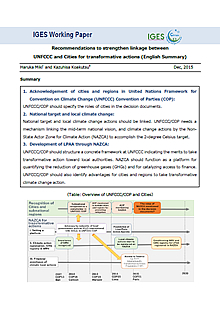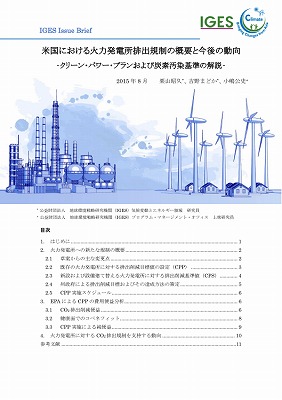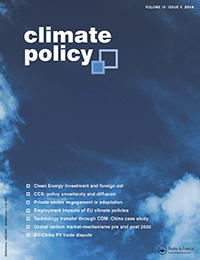This is the summary of a working paper to strengthen linkage between UNFCCC and Cities for transformative actions. In order to accomplish 2-degree Celsius target, national target and local climate change actions should be linked. UNFCCC/COP needs a mechanism linking the mid-term national vision, and climate change actions by the Non-State Actor...
- Clear all
- Publication Year: (-) 2003
- Publication Year: (-) 2015
- Research Unit: (-) Climate and Energy
- Region/Country: (-) Worldwide
Results 1 - 10 of 37 (Sorted by date)
This paper assesses the potential for improving the CO2 intensity of Japan’s electricity sector—the units of carbon dioxide emitted per units of electricity generated—by examining the potential for the feasibility of restarting nuclear power plants and increasing renewable electricity generation by 2030. The analysis shows that, utilizing these two...
On 17 July 2015, the Japanese government unveiled its Intended Nationally Determined Contribution (INDC) to reduce its greenhouse gas (GHG) emissions by 26% below FY 2013 levels by FY 2030 (25.4% reduction below FY 2005 levels). The government also approved the outlook for long-term energy supply and demand, which stipulates that in 2030 the share...
2015年8月3日にオバマ大統領は、大気浄化法のもとで既存の火力発電所からのCO2排出を規制するクリーン・パワー・プランと、新設火力発電所に対するCO2排出基準(炭素汚染基準)を発表しました。 2030年までの火力発電所からのCO2排出を2005年に比べ32%削減する大変意欲的な内容です。オバマ政権による最も重要な気候変動政策と位置づけられているこれらの米国環境保護庁(EPA)による規制について、その内容とともに、規制によるCO2排出削減便益を含む費用便益分析の内容、およびこれらの規制に対する産業界・世論の動向を含めて解説いたします。 Remarks: 2015年10月14日 「2.2既存の火力発電所に対する排出削減目標値の設定(CPP)」において...
In Climate Policy
This article assesses Japan’s carbon budgets up to 2100 in the global efforts to achieve the 2 8C target under different effortsharing approaches based on long-term GHG mitigation scenarios published in 13 studies. The article also presents exemplary emission trajectories for Japan to stay within the calculated budget. The literature data allow for...
This study conducted a comparative assessment of 48 greenhouse gas (GHG) emissions reduction scenarios for 2030 reported in seven studies published since 2011 and based on bottom-up energy system analyses. This study conducted two sets of analyses. First, the scenarios were categorized into four mitigation effort levels and assessed the value...
<要旨> 本稿では、現在公表されている18 GWにおよぶ石炭火力発電の新規建設及び更新(以下、設備追加)計画が日本の温暖化対策に関する中期目標(2030年目標)及び長期目標(2050年目標)に与える影響について分析した。加えて、これらの目標の達成に向けて電力業界全体の実効性のある取組が講じられた際の、石炭火力発電設備に対する経済的リスクについて考察した。 中期目標(2030年目標)の国際的評価と石炭火力発電の設備追加計画が与える影響 2015年4月30日に、日本政府は「2030年度に2013年度比26%削減(2005年度比25.4%削減)」とする約束草案要綱を発表し、長期エネルギー需給見通し骨子を了承した。本骨子では、「2030年の時点での電源構成として原子力発電を20~22%...
In Journal of Cleaner Production
An up-to-date techno-economic assessment was conducted on CO2 emissions reduction potential in the Japanese iron and steel industry for 2030. The following mitigation measures were investigated: (i) maximized installation of best available technologies (BAT scenario), (ii) increased use of coke substitutes in blast furnaces, and (iii) increased use...
EU排出枠取引指令の内容、排出枠取引指令が確定するまでの過程を検証する。そしてこの過程から、ドイツと英国が他国に先駆けて気候政策を展開してきたが故にEU全域における排出枠取引制度の導入によって国内政策との調整を要することを懸念し、排出枠取引策定過程に介入を試みたことを浮き彫りにする。その上で、両国が、その意見が完全に反映されたわけではないにもかかわらず、なぜ最終的に指令に合意したのか、その要因を導き出すことを試みる。








